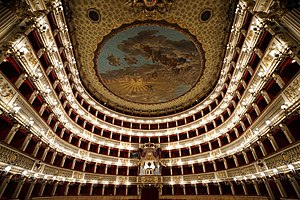Neapolitan School
You can help expand this article with text translated from the corresponding article in Italian. (April 2023) Click [show] for important translation instructions.
|

In
Giambattista Pergolesi, Domenico Cimarosa and Giovanni Paisiello
.
It is with the Neapolitan school...that the History of Modern Music commences—insofar as that music speaks the language of the feelings, emotions, and passions.
— Schluter[4]
The Neapolitan School has been considered in between the Roman School and the Venetian School in importance.[4]
However, "The concept of Neapolitan school, or more particularly Neapolitan opera, has been questioned by a number of scholars. That Naples was a significant musical center in the 18th century is beyond doubt. Whether the composers working in Naples at that time developed or partook of a distinct and characteristic musical style is less clear" since so little is known about the repertory.[1]
Members
- Girolamo Abos (1715-1760)
- Cataldo Amodei (1649-1693)
- Gaetano Andreozzi (1755-1826)
- Pasquale Anfossi (1727-1797)
- Francesco Araja (1709-1770 circa)
- Gennaro Astarita (1749-1805)
- Pietro Auletta (1698 circa-1771)
- Michele Caballone(1692-1740)
- Pasquale Cafaro (1715-1783)
- Luigi Caruso (1754-1823)
- Domenico Cimarosa (1749–1801)
- Carlo Coccia (1782-1873)
- Nicola Conforto (1718-1793)
- Antonio Corbisiero (1720-1790)
- Francesco Corbisieri (1733 circa-1802)
- Giacomo Cordella (1786-1847)
- Giuseppe Curcio (1752-1832)
- Egidio Romualdo Duni(1708-1775)
- Francesco Durante (1684–1755)[2]
- Lorenzo Fago (1704-1793)
- Nicola Fago (1677-1745)
- Pasquale Fago (1740-1994)
- Fedele Fenaroli (1730-1818)
- Francesco Feo (1691–1761)
- Nicola Fiorenza (?-1764)
- Ignazio Fiorillo (1715-1787)
- Domenico Fischietti (1725-1810)
- Gaspare Gabellone (1727-1796)
- Giuseppe Giordani (1751-1798)
- Tommaso Giordani (1730 circa-1806)
- Pietro Alessandro Guglielmi (1728-1804)
- Gaetano Greco (1657circa-1728)
- Giacomo Insanguine (1728-1793)
- Niccolò Jommelli (1714–1774)
- Gaetano Latilla (1711-1788)
- Vincenzo Lavigna (1776-1836)
- Leonardo Leo (1694–1744)[1][2]
- Nicola Bonifacio Logroscino(1698-1765 circa)
- Nicola Manfroce (1791-1813)
- Gennaro Manna (1715-1779)
- Gian Francesco de Majo (1732–1770
- Giuseppe de Majo (1697-1771)
- Francesco Mancini (1672-1737)
- Gaetano Manna (1751-1804)
- Pietro Marchitelli (1643 -1729)
- Gaetano Marinelli (1754-1820 circa)
- Giuseppe Mosca (1772-1839)
- Luigi Mosca (1775-1824)
- Giovanni Paisiello (1740–1816)
- Antonio Palella (1692-1761)
- Silvestro Palma (1754-1834)
- Pietro Domenico Paradies (1707-1791)
- Niccolò Piccinni (1728–1800)
- Giovanni Battista Pergolesi (1710–1736)[1][2]
- Andrea Perrucci (1651-1704)
- Nicola Porpora (1686–1768)
- Giuseppe Porsile (1680-1750)
- Francesco Provenzale (1624–1704)[1][2]
- Angelo Ragazzi (1680-1750)
- Donato Ricchezza (1648-1716)
- Antonio Sacchini (1730-1786)
- Nicola Sala (1713-1801)
- Giovanni Salvatore (1611-1688)
- Angelo Tarchi (1760 circa-1814)
- Giacomo Sarcuni (1690 - 1758)
- Domenico Sarro (1679-1744)
- Alessandro Scarlatti (1660–1725)
- Giuseppe Scarlatti (1718 or 1723-1777)
- Gregorio Sciroli (1722-1781)
- Giuseppe Sellitto(1700-1777)
- Alessandro Speranza (1724-1797)
- Tommaso Traetta (1727–1779)
- Giacomo Tritto (1733-1824)
- Gennaro Ursino (1650-?)
- Vincenzo Lavigna (1776-1836)
- Gaetano Veneziano (1665-1716)
- Giovanni Veneziano (1683-1742)
- Mattia Vento (1735-1776)
- Leonardo Vinci (1690–1730)[1][2]
- Nicola Antonio Zingarelli(1752-1837)
See also
Sources
- ^ ISBN 978-0-674-01163-2.
- ^ ISBN 978-0-393-04074-6.
- ISBN 978-1-56159-263-0. (subscription or UK public library membershiprequired)
- ^ a b Schluter, Joseph (1865). A General History of Music, p.47. R. Bentley.
